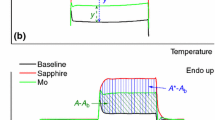Abstract
A new differential thermal analysis method has been developed which allows fast and accurate determinations of phase equilibria in condensed systems between 400 and 1100°. In this method the temperature is increased stepwise, heat effects being determined by analysis of the transient thermoelectric effects after each step. Between steps the temperature is kept constant until equilibrium is attained. The method has been tested in measurements of displacive solid-state transformations and melting points.
Résumé
Une nouvelle méthode d'analyse thermique différentielle a été mise au point. Elle permet de déterminer de façon rapide et exacte les équilibres de phases dans des systèmes condensés, entre 400 et 1100°. Selon cette méthode, on augmente graduellement la température en déterminant les effets thermiques par analyse des effets thermoélectriques intermédiaires après chaque palier. A chaque palier, on maintient la température constante jusqu'à ce que l'équilibre soit atteint. On a contrôlé la méthode par l'étude de changements de phases displacifs dans l'état solide et par mesure de points de fusion.
Zusammenfassung
Eine neue Methode der Differentialthermoanalyse wurde entwickelt, welche rasche und genaue Bestimmungen von Phasengleichgewichten in kondensierten Systemen zwischen 400° und 1100° ermöglicht. Bei dieser Methode wird die Temperatur stufenweise erhöht und die Wärmeeffekte durch Analyse der thermoelektischen Übergangseffekte nach jeder Stufe bestimmt. Zwischen den Stufen wird die Temperatur bis zum Erreichen des Gleichgewichts konstant gehalten. Die Methode wurde bei Messungen von Verschiebungsumsetzungen in festem Zustand und von Schmelzpunkten erprobt.
Резюме
Разработан новый мет од дифференциальног о термического анализ а, который позволяет проводить быстрые и точные опре деления фазового равновесия в конденсированных системах между 400° и 1100°. С огласно этому методу температура поднима ется ступенчато, а тепловы е эффекты определяют ся с помощью анализа промежуточн ых термоэлектрическ их эффектов после каждо й ступени. Между стади ями температура поддерж ивается постоянной для тех по р пока устанавливает ся равновесие. Метод апр обирован при измерен ии твердотельных превр ащений и точек плавле ния.
Similar content being viewed by others
References
A. M. Alper, Phase diagrams, Material science and technology, Academic Press, New York and London, 1970, vol. 1, p. 114.
R. C. Mackenzie, Differential Thermal Analysis, Fundamental Aspects, Academic Press London and New York, 1970, vol. 1.
Thermal Analysis (Proc. of 3rd ICTA, Davos, 1971) vols 1–3, ed. H. G. Wiedemann, Birkhäuser Verlag, Basel and Stuttgart.
Thermal Analysis (Proc. of 4th ICTA, Budapest, 1974) vols 1–3, ed. I. Buzás, Heyden and Son, London, and Akadémiai Kiadó, Budapest.
Handbook of Chemistry and Physics, 52nd Edition. The Chemical Rubber Co., 1971–1972, B 63.
H. G. McAdie, Thermal Analysis (Proc. of 3rd ICTA, Davos, 1971) vol. 1, p. 607, ed. H. H. Wiedeman, Birkhäuser Verlag, Basel and Suttgart.
A. Bellanca, Periodico di Mineralogia, 13 (1942) 21.
N. G.Henriksen (unpublished work).
Author information
Authors and Affiliations
Rights and permissions
About this article
Cite this article
Simonsen, K.A., Zaharescu, M. A new differential thermal analysis method. Journal of Thermal Analysis 15, 25–35 (1979). https://doi.org/10.1007/BF01910195
Received:
Issue Date:
DOI: https://doi.org/10.1007/BF01910195




